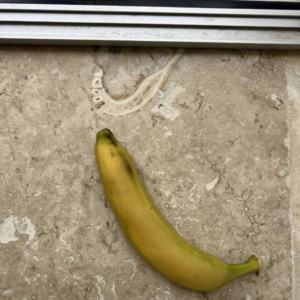
Located on the northern outskirts of the city of Cusco in Peru, lies the walled complex of Saksaywaman (Sacsayhuaman). Renowned for its extraordinary large dry stone walls, meticulously crafted from boulders expertly cut to interlock tightly without mortar, the site is a testament to ancient engineering prowess.
The stones utilized in constructing the terraces at Saksaywaman, some weighing up to 200 tonnes, rank among the largest employed in any pre-Hispanic American building. Their precision of fitting is unparalleled, with gaps so minuscule that a single sheet of paper cannot slide between many of the stones.
This remarkable precision, coupled with the rounded corners of the blocks, the diverse interlocking shapes they form, and the inward-leaning configuration of the walls, has intrigued scientists for decades, prompting ongoing investigation and speculation into the techniques and intentions of the ancient builders.
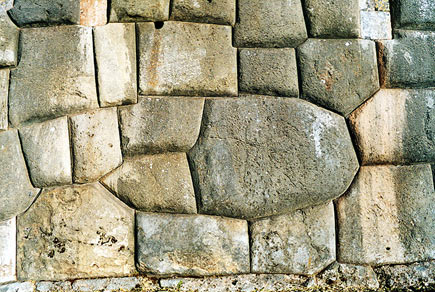
The precise method employed to match the shape of a stone with its adjacent counterparts has spurred extensive speculation and debate. Numerous theories have been proposed, ranging from the softening of stone using a mysterious liquid derived from plants, to mineral disaggregation caused by heat from large sun mirrors, and even the possibility of extraterrestrial intervention.
However, John McCauley, a retired Architect and Construction Manager with over 40 years of experience researching ancient construction techniques, offers a different perspective. He believes that the solution lies in the sheer ingenuity and wisdom of the ancient people who constructed these remarkable structures.
“We have to remind ourselves that the steady rise in mankind’s mastery of technology has taken place over thousands of years of trial and error; mastery of a successful technique in moving heavy stones, or in carving them, has only occurred because of the knowledge passed on through the failure and success of countless ancient engineers who were willing to experiment with a new thought, and have at their disposal a seemingly endless field of labor to execute their ideas,” wrote Mr McCauley, in a paper submitted to Ancient-Origins.
Once at the site, Mr McCauley says the stones were shaped using very heavy “pounders” and countless hours of labour to create the magnificent megalithic walls that can still be seen to this day. Each blow of a diorite boulder, he explained, would remove a small amount of stone until the final shape was attained, “This would take days and weeks, if not months of toil depending on how much material had to be removed.” He explained that another technique, called “trial and error”, was used with much lighter stones. With this method, the stones were shaped with pounders and, as the work progressed, “one stone was mated with another stone until the two finally fitted well”.
The following sequence of photos, using scale models, and descriptions have been provided by Mr McCauley to illustrate how the ancient Inca may have been able to very accurately transfer the shape of stones in the megalithic walls.
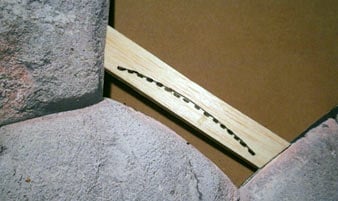 model photo 1
model photo 1
“In this sequence, the assumption is made that an opening has been made in the wall and it needs to be filled with another stone. A wooden board is secured in the opening and spanned to two sides of the opening. A scribe is moved along the edge of the existing stone edge always holding it at the exact same angle to the angle of the wood so as to copy the shape of the stone very precisely
The individual wooden template is then removed from the void space in the wall and is shaped with bronze tools and flint scrapers, resulting in a shape that is true to the edge of the void. The same sequence is performed for each edge of the void space. Each template board is tested against the shape that it copied to verify accuracy.”
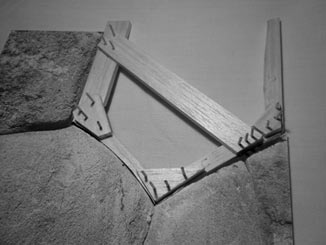 model photo 2
model photo 2
“The master template for the entire void shape is then assembled with wooden dowels and inserted into the existing void space in the wall to verify that it fits exactly. The pinned and doweled joints are verified to be tight.”
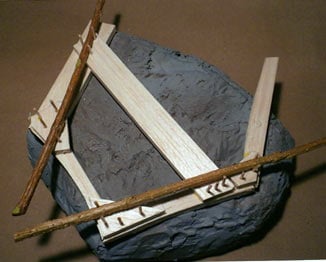 model photo 3
model photo 3
“Now the hard part! The completed wood template is placed over a stone in the marshalling yard which most closely represents the shape needed in the void in the wall. These stones are laying in the stone marshalling yard in front of the wall which is being built. The master template is secured in place with stakes and ropes. The stone masons then transfer the shape of the template to the face of the stone. This transfer of the shape has to be done very accurately and is accomplished by using a narrow scribe board held firmly against the side of the template. This narrow scribe is used to mark the stone so that it can be cut precisely the same shape as the template. The stone masons then remove the template and begin to shape the stone based on the lines that were transferred from the wood template. After the rough carving has been completed, the template is used again to measure the accuracy of the shaping.”
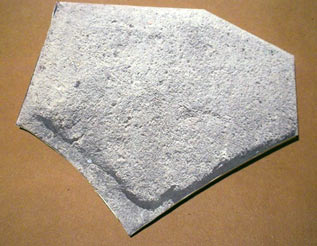 model photo 4
model photo 4
“The “loose” stone from the marshalling yard has now been shaped and its profile double checked against the void space in the wall. Some flattening of the finished face has been accomplished, resulting in the general appearance of “channeling” which is evidenced on many of the stones in the wall.”
Interestingly, most theories that have been put forward regarding the construction of ancient megalithic walls and sites have come from researchers who do not have experience with architecture or construction techniques. But some architects and engineers have argued that such expertise are essential for understanding how these structures were built. Earlier this year, structural engineer, Peter James, put forward an alternative theory for how the pyramids of Egypt were built. In responding to some of his critics, James posed the question: “If you wanted a house built would you use me or an archaeologist?”
Mr McCauley’s research and findings come from the view that our ancient ancestors held a wealth of knowledge that they accumulated over many centuries. “One thing is for sure,” he said, “and that is that early man had a more communicative understanding of Nature, the progression of the heavens, and an intuitive knowledge of how things worked than for which we give them credit”.
News
WNBA Fans Buzz Over “Anne Splashaway” Nickname for Caitlin Clark
Upon witnessing Caitlin Clark’s three-point prowess during the Indiana Fever’s training camp, a WNBA fan took to social media to coin a creative nickname for the 2024 WNBA Draft’s top pick. Inspired by Clark’s sharpshooting skills, the fan cleverly dubbed…
“It wasn’t like this”: Angel Reese notes Clear Distinction in quality between NCAA and WNBA
Angel Reese, a standout college star and 2023 NCAA champion, made waves in the 2024 WNBA draft when she was selected by the Chicago Sky as the seventh overall pick. Since joining the team, Reese has been fully committed to…
“No deposit, no return mindset”: Indiana Fever Coach Establishes Standards for Caitlin Clark, Aliyah Boston, and Co Prior to Season Opener
All eyes are fixed on the Indiana Fever ahead of the 2024 WNBA season, following their acquisition of the highly coveted consensus number one overall pick, Caitlin Clark, in the 2024 WNBA draft. Amidst heightened expectations, head coach Christie Sides…
Dentist Finds What May Be A Prehistoric Human Jawbone Embedded In His Parents’ New Floor
The discovery of a human mandible embedded in travertine flooring during a home renovation in Europe has sparked curiosity and raised questions about its origins. The mandible was noticed by the homeowner’s son, a dentist, who recognized its unmistakable shape….
Researchers Have Successfully Created Artificial Cells That Act Just Like Human Cells
The University of North Carolina at Chapel Hill researchers have achieved a significant breakthrough in biotechnology by engineering artificial cells with life-like behavior using DNA-peptide technology. In their experiment, the team manipulated peptides and genetic material to create cell cytoskeletons,…
LA Sparks 1st Rounder Cameron Brink and Mother Groove to GloRilla’s Beats in Latest TikTok, Sporting $8,600 Hermes Bag
Cameron Brink shares a close bond with her mother, Michelle, often showcased on social media. Recently, they posted a TikTok video dancing to the rhythm of rapper GloRilla’s “Yeah Glo!” In the clip, the former Stanford standout was spotted accessorizing…
End of content
No more pages to load



